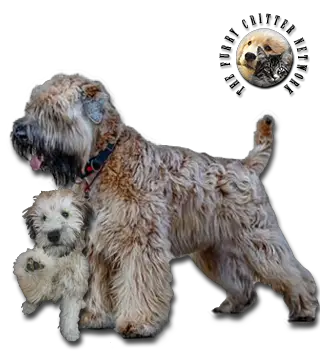Breed Standard
Head: Long and powerful. Flat skull, not too wide. Pronounced stop. Powerful, "fearsome" jaws.
Ears: Small to medium size. Carried forward, breaking level with the skull.
Eyes: Not too large. Dark hazelnut or dark color.
Body: Short, compact. Strong neck without dewlap. Deep forechest. Ribs well sprung. Short, powerful loin. Straight topline.
Tail: Not too thick; carried gaily. Docked to one-third its natural length (after the sixth vertebra).
Hair: Abundant, soft texture, silky, wavy or loose curls. Must not exceed 12.7 cm at greatest length.
Coat: Any shade from light wheaten to golden-reddish. The texture and color of the puppy’s coat passes through several stages before attaining its permanent color at one and one-half to two and one-half years of age.
Size: Dog: 46 to 48 cm (18-19 in).Bitch: 43 to 47 cm (17-18.5 in).
Weight: Dog: 15.7 to 18 kg (35-40 lb).Bitch: 13 to 15 kg (29-33 lb).
History
The Wheaten was bred in Ireland for over two hundred years to be an all purpose farm dog whose duties included herding, watching and guarding livestock, and vermin hunting and killing. They share a common ancestry with the Kerry Blue Terrier and the Irish Terrier but were not owned by gentry. In Ireland, they were commonly referred to as the "Poor Man's Wolfhound." Their tails used to be docked to avoid taxes and were often kept to a specific size.
Despite its long history, the Wheaten was not recognized as a breed in Ireland by the Irish Kennel Club until 1937. In 1943, the British Kennel Club recognized the breed in the UK as well. The first Wheatens were exported to Lydia Vogel in the United States in the 1940s, but serious interest in the breed took another ten years to develop. The Soft Coated Wheaten Terrier Club of America, Inc. was established in 1962, seven years after the formation of The Soft Coated Wheaten Terrier Club of Great Britain. In the 1970s, the first Wheatens were imported into Australia by Anubis Kennels. In 1973, they were recognized by the American Kennel Club. The recent importation of Irish-style dogs has improved and broadened the gene pool. The American Herding Breed Association (AHBA) accepted the Wheaten in the 1990s at which point members of the breed were allowed to participate in its herding capability tests and trials. Today, Wheatens compete in obedience, agility, and tracking and are occasionally used in animal-assisted therapy as well. The Soft Coated Wheaten Terrier Club of America, Inc. (SCWTCA, Inc.) is a member of the American Kennel Club which protects and advances the interests of the breed and guards against commercial exploitation.
Behavior
The Soft-coated Wheaten Terrier is an energetic and playful dog. It requires patience and consistent positive training. Harsh methods will often result in fear and/or aggression. A positive, even-handed approach works best with this intelligent yet headstrong terrier. It is an enthusiastic greeter, and will often jump up to lick a person's face, commonly referred to as the "Wheaten greetin". Wheatens are considered less scrappy than other terriers, but are lively and can be more active than many other breeds. For this reason these dogs do best when they are exercised regularly.
They are cool-weather dogs and can become easily overheated in hot weather. If socialised with cats and puppies, they may get along fine with them; if not, care should be taken in introducing them to cats, as the breed has a very strong "prey drive" because of its vermin-hunting origin. Wheatens are friendly and loving pets, and get along well with other dogs if properly socialised. Wheatens are very protective of their families and, although they may bark in alert at strangers, they rarely get aggressive. Many Wheaten owners thus say they make great watch dogs, but poor guard dogs. Wheatens are a great dog for children and are generally friendly towards them.
He needs considerable space and exercise to maintain his mental health. Regular brushing is required. Grooming may be required from time to time.
Function
Livestock Guard, Hunting Dog, Watch Dog, Pet.
Health
Soft-coated Wheaten Terriers are generally a long-lived breed. They are susceptible to various heritable diseases, although are most known for two protein wasting conditions: protein-losing nephropathy (PLN), where the dogs lose protein via the kidneys; and protein-losing enteropathy (PLE), where the dogs fail to fully absorb protein in their digestive tracts, causing it to pass in their stool. Both PLN and PLE are potentially fatal, but if caught early enough, can sometimes be managed with strict dietary changes and pharmaceuticals. Laboratory tests can aid in diagnosing PLN and PLE; Wheaten owners should check their country's advised testing protocols. Research suggests that PLE and PLN often are more prevalent in female wheatens and often happen in concurrence, with PLE following diagnosis of PLN. While a genetic predisposition has been suggested, an unknown mode of inheritance remains. Research programs, mainly in the United States and the United Kingdom, are looking for answers.
Other Wheaten health issues are renal dysplasia, inflammatory bowel disease, Addison's disease, and cancer. Some Wheatens can suffer from food and environmental allergies, and can be prone to developing the skin disease atopic dermatitis. Potential owners of Wheaten Terriers should discuss health issues with a breeder before deciding to get a puppy.






